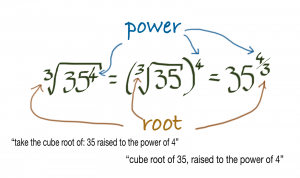Evaluate a radical using number facts
For each new math fact that we calculate, we get at least one more math fact for free:
![]()
Gives us ![]() and
and ![]() .
.
Similarly, we can calculate
![]()
This gives us the related fact
![]()
In this section, it is useful to recall common exponent facts in order to evaluate roots. Consider completing this Reference Sheet for Exponents. Refer to this sheet rather than a calculator for common values.
Roots and Exponents
Let’s compare what we know about roots and exponents. We know the exponent law that says ![]() . We also know that
. We also know that ![]()
We can write that:
![]()
.
Note that:
![]()
and
![]()
In other words, ![]() and
and ![]() are the same number. You can type them both on your calculator and get the same answer.
are the same number. You can type them both on your calculator and get the same answer.
Extending the idea, we have
![]()
In other words,
![]()
And in general:
![]()
Evaluate a fraction exponent that has a power and a root
Consider a number such as
![]()
![]()
![]()
Therefore,
![]()
Now, as an exponent, the cube root is the same as the exponent ![]() , the first part reads:
, the first part reads:
![]()
The second part is, ‘raise to the power 4’:
![]()
The an exponent law that reminds us what do to here: ![]() . So we can write:
. So we can write:
![]()
When it comes to converting from root notation to exponent notation or vice versa:

In general, as long as the base a is a positive number:
![]()
Notation
The idea of powers and roots has been around for a very long time, but the way we write them down and communicate them has changed over the years. You can see from this table, called ‘the origins of some mathematical symbols‘ that the square root symbol, ![]() has been around since 1524; and exponents as we now use them showed up 100 years later, they have been around since 1637.
has been around since 1524; and exponents as we now use them showed up 100 years later, they have been around since 1637.
We now use both notations interchangeably, but one can note a preference for root notation in geometry and for exponent notation in calculus.
Evaluating fraction exponents
Generally, a fraction exponent leads to an irrational number. The answers to these examples are integers or rational numbers, and can be evaluated without using a calculator.
Example1: ![]()
What is the second (square) root of 16? ![]()
Example 2a: ![]()
What is the fourth root of 16? ![]() For the fourth root you can square root then square root again:
For the fourth root you can square root then square root again:
![]()
Example 2b: ![]()
First, we need to know that ![]() .
.
This is how we handle it:
We know that ![]() .
.
And we know that ![]()
This is why we can rewrite ![]() as
as ![]()
In this form, we first evaluate the bracket from recall or the reference sheet then calculate the power:
![]()
Alternatively, convert to root notation then compute: ![]()
Example 3: ![]()
We mean, take the cube root of 125 then square it.
![Rendered by QuickLaTeX.com \begin{align*}125^{\frac{2}{3}} \\[10pt]&= \big(125^{\frac{1}{3}}\big)^2 \\[10pt]&= \big(5\big)^2\\[10pt]&=25\end{align*}](https://tentotwelvemath.com/wp-content/ql-cache/quicklatex.com-351a743c4a31763044feb7b5a89b78ce_l3.png)
Example 4: ![]()
We mean, take the square root of 64 then cube.
![Rendered by QuickLaTeX.com \begin{align*}64^{\frac{3}{2}} \\[10pt]&= \big(64^{\frac{1}{2}}\big)^3 \\[10pt]&= \big(8\big)^3\\[10pt]&=512\end{align*}](https://tentotwelvemath.com/wp-content/ql-cache/quicklatex.com-b40360c3f5d95aed05097bb2e6321d12_l3.png)
Example 5:![]()
The reference sheet shows that ![]() . Multiplying by 4 one more time gives
. Multiplying by 4 one more time gives ![]() .
.
![]() .
.
![]()
Evaluate negative exponents
Division can be expressed using ![]() or by using a fraction or by using a negative exponent. A negative exponent does not make the value negative because dividing does not make a value negative.
or by using a fraction or by using a negative exponent. A negative exponent does not make the value negative because dividing does not make a value negative.
1 divided by 7 can be written as:
![]()
Note that all of these are positive (all are equal to ![]() ). Generally the first thing we do with a negative exponent (which means ‘divide’) is to write it as a fraction.
). Generally the first thing we do with a negative exponent (which means ‘divide’) is to write it as a fraction.
Example 6: ![]()
A negative exponent represents repeated division.
![Rendered by QuickLaTeX.com \begin{align*}2^{-3}\\[10pt]&=1 \div 2^3\\[10pt]&=\frac{1}{2^3}\\[10pt]&=\frac{1}{8}\end{align*}](https://tentotwelvemath.com/wp-content/ql-cache/quicklatex.com-45745b854cb8628e7bbdb8646648e6ec_l3.png)
Example 7: ![]()
![Rendered by QuickLaTeX.com \begin{align*}25^{-\frac{3}{2}}\\[10pt]&=\frac{1}{25^\frac{3}{2}}\\[10pt]&=\frac{1}{\big(25^\frac{1}{2}\big)^3}\\[10pt]&=\frac{1}{5^3}\\[10pt]&=\frac{1}{125}\end{align*}](https://tentotwelvemath.com/wp-content/ql-cache/quicklatex.com-d98581e54e34fa647cd2a4fee8aea45f_l3.png)
Fractions with Negative Exponents
In examples 8, 9 and 10 we take a negative power of a fraction. To understand the process, you need to remember how to divide a fraction. Here’s a reminder:
![Rendered by QuickLaTeX.com \begin{align*}\frac{3}{4}\div \frac{7}{11}\\[10pt]&=\frac{3}{4}\times\frac{11}{7} \\[10pt]&=\frac{33}{28}\end{align*}](https://tentotwelvemath.com/wp-content/ql-cache/quicklatex.com-768f7253635d47eb458ca7f04a64fdca_l3.png)
Example 8: ![]()
Watch what happens to the fraction when there is a negative power.
![Rendered by QuickLaTeX.com \begin{align*}\big(\frac{4}{5}\big)^{-2}\\[10pt]&=\frac{1}{\frac{4^2}{5^2}}\\[10pt]&=1\div \frac{4^2}{5^2}\\[10pt]&=\frac{1}{1}\times\frac{5^2}{4^2}\\[10pt]&=\frac{5^2}{4^2}\\[10pt]&=\frac{25}{16}\end{align*}](https://tentotwelvemath.com/wp-content/ql-cache/quicklatex.com-d640c83e6920ecf8739b28b96322e6d3_l3.png)
Notice that our original fraction flips when the exponent is negative. Let’s write that down in general:
In general,
![Rendered by QuickLaTeX.com \[{\Big(\frac{a}{b}\Big)^{-n}=\Big(\frac{b}{a}\Big)^n}\]](https://tentotwelvemath.com/wp-content/ql-cache/quicklatex.com-a5c702f9fb867519e12756b1b0d869e5_l3.png)
Example 9: ![]()
![Rendered by QuickLaTeX.com \begin{align*}\Big(\frac{1000}{343}\Big)^{-\frac{1}{3}}\\[10pt]&=\Big(\frac{343}{1000}\Big)^{\frac{1}{3}}\\[10pt]&=\frac{343^{\frac{1}{3}}}{1000^{\frac{1}{3}}}=\frac{7}{10}\end{align*}](https://tentotwelvemath.com/wp-content/ql-cache/quicklatex.com-e3d1cd759e9af6b402aa76192eccf222_l3.png)
Example 10: ![]()
![Rendered by QuickLaTeX.com \begin{align*}\Big(\frac{125}{8}\Big)^{-\frac{2}{3}}\\[10pt]&=\Big(\frac{8}{125}\Big)^{\frac{2}{3}}\\[10pt]&=\frac{8^{\frac{2}{3}}}{125^{\frac{2}{3}}}=\frac{4}{25}\end{align*}](https://tentotwelvemath.com/wp-content/ql-cache/quicklatex.com-a553bfb63f332483ac76f3fc678d1fbb_l3.png)
Your turn:
